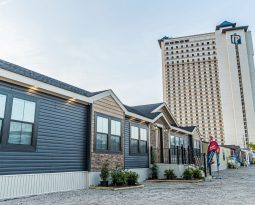MANUFACTURED HOME PARK VACANCY TIGHTENS, SPACE RENT INCREASES
“Under ordinary competitive conditions, any long and serious maladjustment between supply and demand cannot last” – George W. Stock, author
According to MHN Multi-Housing News, vacancy in manufactured home communities continues to tighten across all regions., as homebuyers increasingly turn to the low cost manufactured housing options, according to a new national market report by Marcus and Milichap, a nationwide real estate services company.
The West’s Mountain region maintains the lowest vacancy rate nationwide at 5.1 percent, down 50 basis points from the previous year. The East North Central of the Midwest posted the highest vacancy rate in the country at 14.6 percent, after experiencing the largest year-on-year of 110 basis points in July, the brokerage found. In the Mid-Atlantic and Northeastern regions, vacancy was 5.9 percent and 4.3 percent.
Supply And Demand: Urban Areas Have Lowest Vacancy Rate And Ever-Increasing Rents
Among metropolitan areas, the most supply-starved markets are Denver, Miami, Long Island and several markets in California where vacant spaces are almost non-existent (less than 1 percent). Rising demand and lack of new manufactured home community development is driving rent increases nationwide. The South registered the largest rent increase, with rents jumping 3.9 percent annually to $580.00 per month as of July, In the East, rent increased 3.7 percent.
Miami, Fort Myers and Naples, Fla., were among the metro areas that saw rent growth of more than 8 percent over the last 12 months. The costliest manufactured home spaces are found in Denver, where average monthly rent stands at $736.
Hungry Investors Competing For Manufactured Home Communities
Investor competition for manufactured home/mobile home communities is heating up, as an abundance of buyers jostle for scarce assets listed for sale. This is causing some investors to adjust their parameters by considering smaller communities, hunting in secondary and tertiary markets, and considering properties with shortcomings such as lack of city services, according to the report.
Among the factors drawing new investors to the manufactured home community sector are steady cash flows, the potential for higher returns and reduced management headaches compared to other property types. The scarcity of product means that large top tier communities that do hit the market will attract multiple offers from a range of buyers, driving sale prices higher. Marcus and Millichap finds the cap rates for these assets tend to fall in the 4 to 5 percent range but can be as low as 3 percent.
Manufactured housing community REITs (Real Estate Investment Trust) are surging. In the 12 months through May 31, 2019, for example, the manufactured home sector led all publicly traded U.S. REIT sectors by posting a 29.5x funds from operations (FFO) multiple.
Here at ManufacturedHomes.com we have been following the flurry of manufactured/mobile home investor acquisitions over the last several months. More often than not, the new owner will raise resident rental rates, often dramatically, creating an affordability crisis for many, especially in age regulated communities where many of the residents have fixed incomes and zero options to relocate their home.
For more information click the following recent reports:
“Few Resident Options Available When Mobile Home Park Closes Or Acquired by Investor.” — “Silicon Valley Mobile Home Park Sells for $237 Million” — “City of Fullerton, California May Consider A Moratorium On Rent Hikes For Mobile Home Park, On Their Side Of the Border”







